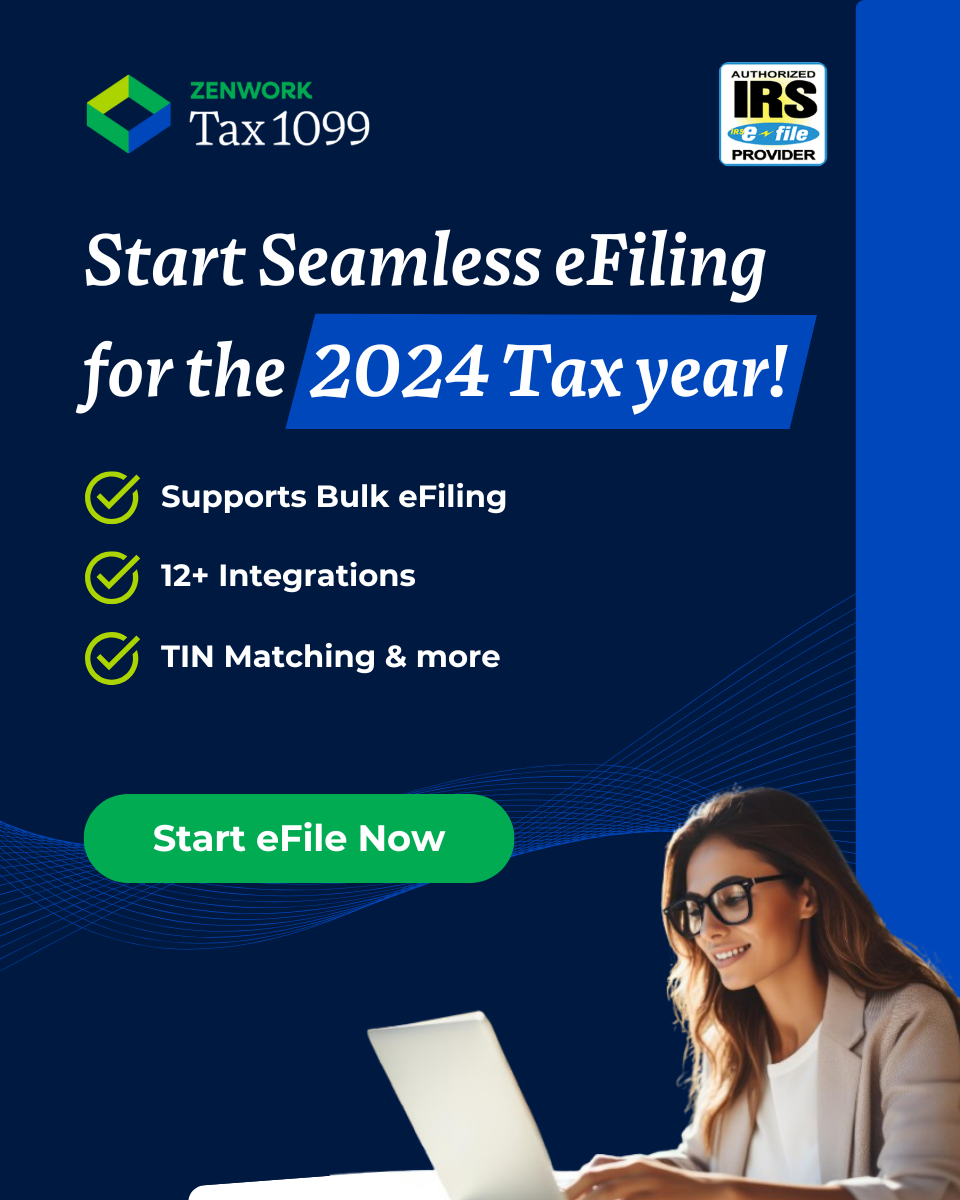Tax1099, powered by Zenwork, is here to update you on the pending changes to information reporting, including the redefinition of independent contractors under the FLSA (Fair Labor Standards Act).

The US Department of Labor is set to publish a Notice of Proposed Rulemaking this Thursday, October 13, 2022. The notice sets out to re-define the term “independent contractor” under the Fair Labor Standards Act (FLSA). This change to the rule could affect how “nonemployee compensation” is reported for future filing seasons.
How will the proposed changes impact the income reports of independent contractors, especially since the restoration of Form 1099-NEC, is yet to be seen. At this point, tax and compliance experts can only wait.
So, What’s Changed?
A recent news release stated that the proposed rule from the Department of Labor provides “…guidance on classifying workers and seeks to combat employee misclassification (…) that denies workers’ rights and protections under federal labor standards, promotes wage theft, allows certain employers to gain an unfair advantage over law-abiding businesses, and hurts the economy at-large.”
The department believes that the classification protects vulnerable workers that aren’t under the purview of federal labor and wage protections.
With the recent changes that have taken place since the beginning of the decade to worker classifications, it’s important to understand how this might affect the way your business or entity classifies workers in the future, keeping in view the tax compliance complexities.
Once the new rules are clearly established, it will be important to work with a partner that is ready to implement any income classification changes ahead of the next filing season.
Defining “Independent Contractors vs. Employees”
In 2021, we published an article that defines the term independent contractor per the regulatory scenario of that year. This information will now be important to understand and compare the changes that are ahead of us, as the Department of Labor seeks to redefine these terms again.
Currently, ‘Employees’ are defined as individuals recruited by the employer for a specific term or an indefinite period.
Here’s the information covered under that definition:
- Businesses should report employee compensations with IRS Form W-2.
- Employee compensation is defined as salaries, wages, health insurance, unemployment benefits, bonuses, and other variables.
- Employees are prohibited from delegating their tasks to other resources unless the employment contract makes an exception for it.
- Employee compensations are subject to federal tax withholding.
- Employees are defined as employees of the company or entities of the employer.
- There is no minimum payment threshold for employees and all compensation must be reported on Form W-2.
A non-employee (or independent contractor) is an individual or entity that is hired for a specific project and/or work for a predefined period.
Here’s some additional information about “non-employee” classification:
- Independent contractors are considered “self-employed” and commissioned for work by entities or individuals.
- Their compensation is defined as payments made to the independent contractor in exchange for services.
- Independent contractors are allowed to delegate their tasks to internal and external resources as needed.
- Non-employee compensations are subject to federal tax withholding only when the vendor doesn’t provide their taxpayer identification number or submits an incorrect TIN.
- Payments of more than $600 or more made to an independent contractor/non-employee (in the course of business) are subject to reporting.
What Is Prompting These Changes?
The distinction is important as the Department of Labor believes employers and entities are taking advantage of the nonemployee compensation classification to avoid properly compensating workers.
The National Employment Law Project says “(misclassification) deprives employees of core rights and protections such as minimum wage, overtime pay, contributions to Social Security, the right to collective bargaining under the National Labor Relations Act, workers’ compensation, unemployment compensation, and protection from discrimination.”
There are many ways employers can misclassify someone.
The NELP study states that many workers are labeled as independent contractors because employers require them to form a limited liability company as a condition for working, even when these employees are not running their own businesses or have little experience with those operations.
These workers, based on the study, can be paid off the books as a result, without being reported as part of that company’s payroll. These workers are frequently required to sign contracts that set standards and guidelines for the employee without placing them on the payroll.
Changes to the proposed ruling seek to eliminate these instances and clearly define the terms.
Changes To The Proposed Ruling
Updates to the definition of “independent contractors” have been in the works at least since the summer, when the Department of Labor solicited the feedback shared by stakeholders in forums.
The department will continue to obtain more feedback before any changes are incorporated for regulatory reporting in 2023.
Redefining nonemployees through the proposed ruling would:
- Align the department’s approach with courts’ FLSA interpretation and the economic reality test.
- Restore the multifactor, totality-of-the-circumstances analysis to determine whether a worker is an employee or an independent contractor under the FLSA.
- Ensure that all factors are analyzed without assigning a predetermined weight to a particular factor or set of factors.
- Revert to the long-standing interpretation of the economic reality factors. These factors include the investment, control and opportunity for profit or loss factors. The integral factor, which considers whether the work is integral to the employer’s business, is also included.
- Assist with the proper classification of employees and independent contractors under the FLSA.
- Rescind the 2021 Independent Contractor Rule.
Whom Does This Affect?
This could potentially affect thousands of gig economy workers and other independent contractors who are classified as non-employees or independent contractors.
Just last month, Uber agreed to settle an over $8 Million Class Action Settlement with California drivers who claim they were misclassified as independent contractors instead of employees.
That classification contradicts California Assembly Bill 5, which states that workers must be classified as employees unless they are free from the employer’s direction and control in connection with work performance, doing work that is outside the employer’s usual course of business, and engaged in an independently established trade, occupation, or business.
The argument from critics of the current classification is that an Uber driver or another gig economy worker who is hired as an independent contractor is not subject to minimum wage pay and overtime.
Critics also say that such classified Uber drivers are also not entitled to mandatory meal and rest breaks, business reimbursement expenses, and itemized wage statements.
Lyft and other large players in the gig economy platform space have stated that there would be no immediate impact to their business as a result of this proposal, but it remains to be seen whether that holds true when the rulemaking concludes.
Stay Ahead Of Compliance Updates With Tax1099
As the IRS’ guidelines evolve due to these changes from the Department of Labor, gig economy platforms and other employers that utilize services from independent contractors will need a solution like Tax1099 that stays ahead of these changes.
Tax1099, powered by Zenwork, has an incredible API ecosystem that covers everything you need to get ready for future information tax seasons.
Tax1099 API Features Include:
- W9 Collection
- Tax Exempt Check
- Form Filing, including W2 and 1099-NEC
- Real-Time TIN Check
- Real-Time Status Checks
- PDF Generation and secure delivery
With decades of experience handling regulatory updates for various industries, Tax1099 is ready to help you navigate through yet another year of change.
Enterprise Industries Leveraging Tax1099’s API:
- Payment processors
- Banks
- Digital asset exchanges
- Neobanks
- Fintech platforms
- Accounting firms
- Online marketplaces
- Logistics
And many more.
We offer competitive tier pricing, world-class customer service by phone, chat, and email, and extended hours for assistance as the January 31 information tax season deadline approaches.
To learn more, visit www.Tax1099.com


